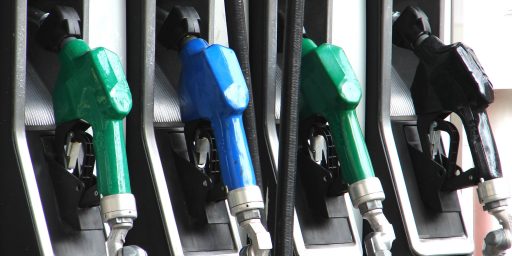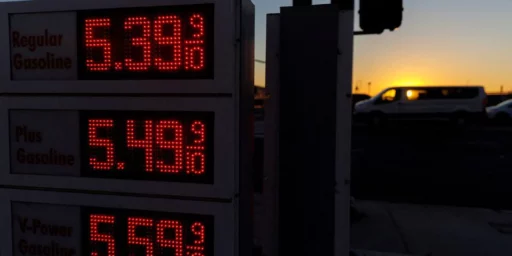Analysts Say Gas Prices May Have Peaked
Once again, those predictions of $5.00 gas may have been much ado about nothing.
The panic over $5.00 per gallon gas may have been overblown:
Gasoline prices, which have vexed President Obama politically in recent months, may have reached their peak, according to energy analysts.
Prices at the pump reached nearly $3.94 last Friday, the highest point this year, according to AAA. But prices have decreased slightly over the last five days, reversing increases that began in December of last year.
Analysts say prices could continue to decline.
“What this could potentially mean for motorists is that prices could take a bit of a breather or they might fall,” said Patrick DeHaan, senior petroleum analyst at gasbuddy.com.
“Traditionally, every spring we see prices rise like this,” DeHaan added. “They tend to peak in late spring.”
Ben Brockwell, director of data and pricing at the Oil Price Information Service, said gasoline prices have decreased more in the last five days than any time during the past year.
Based on the average increase during the first three months of the year, gasoline prices should have hit a national average of $4 a gallon on Tuesday, according to Brockwell’s early projections.
“But the trend is certainly reversing nationally,” he said, blaming the change on a “shift in psychology” in the oil futures markets. “It’s reasonable to think that prices have peaked for the summer.”
But Brockwell warned that unforeseen events like increased tensions in Iran could cause gasoline prices to spike again.
“The reality is, we’re only one event from prices going back up,” he said.
As I’ve said before, the factors that drive fuel prices up are largely out of the control of political actors, and the same goes for the factors that end up driving them down. In addition to the international issues that Brockwell raises, which are a spark that could be lit at any moment without warning, there are also issues related to seasonal fuel blends as well as demand from overseas for oil and its derivatives. Indeed, for several months now the United States has been a net exporter of gasoline. The role of a warmer-than-normal winter in differing driving habits should also not be discounted. And those are only the most obvious of many factors that are involved in determining fuel prices. The idea that the pattern we saw in January was going to continue forever, or even for more than just a few months, is simply absurd and lazy reasoning on the part of the public, the media, and politicians.
That’s why it’s also worth noting that the mere fact that gas prices have fallen in the past five days doesn’t mean that we’re out of the woods:
But a report released Tuesday by the federal Energy Information Administration (EIA) suggests that the president may not want to get his hopes up that prices will tumble just yet.
“During the April-through-September summer driving season this year, regular gasoline retail prices are forecast to average about $3.95 per gallon, peaking in May at a monthly average price of $4.01 per gallon,” the monthly Short-Term Energy Outlook says.
And, as I noted just last month, we’ve been down this road before:
It was just about a year ago that gasoline prices were also starting to spike, and some were predicting that the price of gas would hit $5.00 per gallon by summer. In that case, unlike now, the spike in gas prices was accompanied by a spike in oil prices. By April, polls were starting to show that the President’s job approval numbers were being impacted by energy prices although other polls showed that Americans weren’t necessarily blaming the President for the rise in energy prices. Then, gas prices started to drop dramatically and the summer of $5.00 gas never arrived.
One oil analyst believes that this is exactly what will happen:
Tom Kloza, chief oil analyst at the Oil Price Information Service, told The Hill last month that, despite all of the politics surrounding gas prices, the 2012 spike is part of a “natural rhythm” that occurs annually.
“It’s an election year, so it’s getting a lot more attention,” Kloza noted.
He said gasoline prices usually increase and hit their peak in the spring only to decrease and reach their lowest point in November, just in time for the election.
“It absolutely has nothing to do with politics, but the first week of November is election week,” Kloza said.
Of course, as the financial analysts say, past performance is not indicative of future results. It’s entirely possible that any one of the number of factors mentioned above could come into play, causing oil and gas prices to skyrocket at precisely the right (or wrong depending on your perspective) time.







So these analysts are better than the other analysts?
We could regulate speculation…which is anything but a “free-market” and is completely disconnected from supply and demand…or we could just pretend there is nothing we can do.
Historically speculation accounted for about 30 percent of oil trading while producers and end users made up about 70 percent. Now it’s the opposite Producers and end users make up about 30%. The FRB of St. Louis claims that speculators accounted for about 15-20 percent of the increase in price for crude oil in the last decade. Commodity Futures Trading Commissioner Bart Chilton recently noted several independent studies indicating that excessive speculation is driving up the price of gas.
The current market is a casino…where hedge funders wager on how high they can push the prices. Maybe there is a limit to how far speculators are willing to push. Maybe not. As long as we keep pretending this is some sort of free-market capitalism then we are going to find out.
Generally speaking the chances that gasoline prices will peak before Memorial Day are about the same as the chances of the S&P 500 hitting its annual high point in August or September, which is to say not bloody likely.
Although it’s touching at one level that the core Democrat paper “The Hill” managed to find a couple of analysts with which to push its obvious agenda, in reality we’ll have to wait at least until Memorial Day (and perhaps until later in the summer) before we have a firm grasp on whether or not gas prices already have peaked this calendar year. It’s possible that’s the case. Highly doubtful, however. I wouldn’t bet the farm on it.
That all said, there was one point in that article on which The Hill’s mouthpiece was almost completely correct: gas prices always fall after Labor Day and generally hit their annual low points in or around November. Like clockwork.
I ask this to everyone. Why would Americans actually think that the POTUS has almost any power over gasoline prices or energy prices in general? I have my own thoughts that don’t hold average Americans in high esteem on this one…
@Tsar Nicholas:
Haven’t taken your paranoia medication today Counsellor?
Tsar N, why would a Democrat paper push this analysis when there’s no guarantee that it will come to fruition? The political reward of predicting lower gas prices this summer is not worth the risk. Better to just let it run its course and not take the blame or the credit.
Huh. I could’ve sworn the panics were over $4.00/gallon gas.
I think it comes as a shock to many conservatives, but the price of oil dictated by supply and demand considerations and is determined in the commodity markets and not by the President of the United States.
As recently as 7 years ago we imported over 60% of our oil now it’s down to 49%. We’re big energy consumers, and now so too, is China. $4.00 per gallon? We’ve been there as recently as 4 years ago.